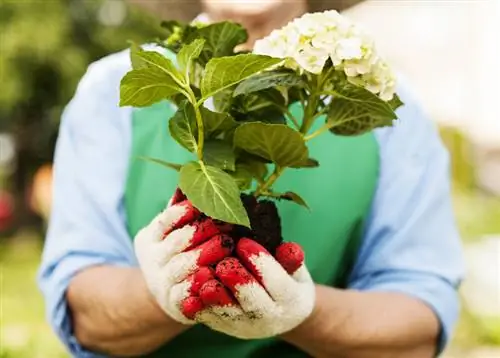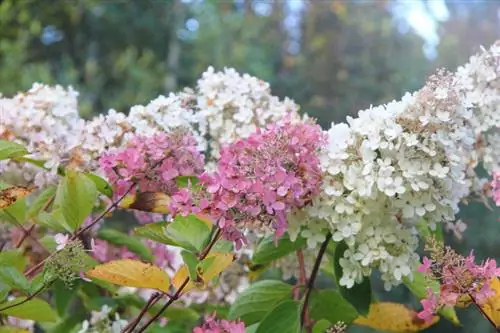- Author admin [email protected].
- Public 2023-12-16 16:46.
- Last modified 2025-01-23 11:20.
Although farmer's or garden hydrangeas are much more common in German gardens, the mostly white to pink flowering panicle hydrangea is much better suited to the local climate due to its greater winter hardiness. It thrives in sunny to partially shaded locations and requires little care.

How should you fertilize panicle hydrangeas?
Panicle hydrangeas should be fertilized in spring with organic fertilizer such as mixed compost or cattle manure and horn shavings in the root area. Potted plants and plants on nutrient-poor soils also require a suitable liquid complete fertilizer such as hydrangea fertilizer, rhododendron fertilizer or azalea fertilizer every 8 to 14 days.
Provide panicle hydrangeas with organic fertilizer
Pranicle hydrangeas like humus- and nutrient-rich soil that is acidic to neutral, but often do well on poor, slightly alkaline soils. If your panicle hydrangea is in a rich substrate, fertilizing with organic material is basically sufficient. In the spring, before sprouting, work plenty of mixed compost or cattle manure and horn shavings into the root area; a little later you can also mulch this region. Mulching also has the advantage that moisture remains in the soil and you have to water less.
Water panicle hydrangeas sufficiently
Compared to other types of hydrangeas, panicle hydrangeas are quite insensitive to drought. Of course, you shouldn't have to go thirsty, after all, hydrangeas generally need a lot of water. Mulch the root area and check the plant regularly for signs of water deficiency. Water heavily in dry times and in summer, although watering is best done in the early morning or evening hours, especially in the warm season.
Complete fertilizer only necessary on poor soils
Sometimes organic fertilization of panicle hydrangeas is not enough, so you have to supply your panicle hydrangea with mineral fertilizer. This is particularly true for specimens on nutrient-poor soils, but also for potted plants. Panicle hydrangeas cultivated in pots should be supplied with a suitable fertilizer (€8.00 on Amazon) about every 8 to 14 days, although a complete liquid fertilizer is particularly suitable. Fertilizers suitable for hydrangeas are:
- hydrangea fertilizer
- Rhododendron fertilizer
- or azalea fertilizer.
In order to prepare the panicle hydrangeas for winter in good time, you can reduce and then stop fertilizing from the end of August.
Yellow leaves indicate nutrient deficiency
If the leaves of your panicle hydrangea turn yellowish, with the leaf veins often remaining green, then there is chlorosis, i.e. H. a nutrient deficiency. However, this can have many causes and does not have to be due to a lack of fertilization. Panicle hydrangeas are very sensitive to waterlogging. The rotting roots, in turn, can no longer adequately supply the above-ground parts of the plant, which promptly leads to chlorosis. So check exactly why your panicle hydrangea is suffering from a deficiency and then take targeted action.
Tips & Tricks
An unsuitable, i.e. H. soil that is too alkaline or calcareous. In such a case, mixing in rhododendron or ericaceous soil helps.






